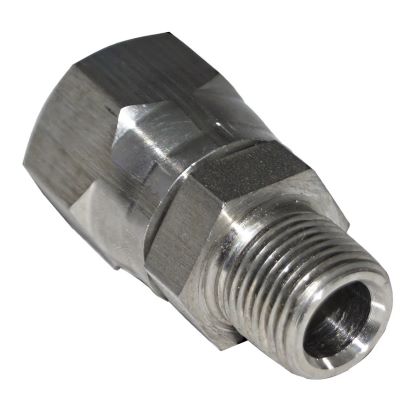When it comes to hydraulic connections, JIC is a name that often comes up. But with so many options available, it can be tough to decide whether JIC is the right choice for your specific needs. In this blog post, we’ll dive deep into JIC connections, comparing them to other common types and exploring the key factors to consider when making your selection.
So, let’s get started and find out if JIC is the best fit for your hydraulic system.
What is a JIC Connection? A Deep Dive
A JIC (Joint Industry Conference) connection is a hydraulic connector standard widely used in industrial applications. It’s characterized by its unique 37° flare angle, O-ring seal, and pressure-tight design. The primary components of a JIC connection include:
➡️Flare nut: A hexagonal nut with a tapered bore that compresses the flare face of the fitting.
➡️ Flare fitting: A fitting with a tapered end that forms a seal when compressed by the flare nut.
➡️ O-ring: A rubber or elastomeric ring that provides an additional seal between the flare nut and fitting.
How JIC Connections Work: The Mechanics Behind the Seal
JIC connections rely on a combination of mechanical compression and sealing elements to create a leak-free seal. When the flare nut is tightened, it compresses the flare face of the fitting, creating a conical seal. The O-ring, located between the flare nut and fitting, provides an additional layer of sealing, preventing fluid leakage.
Common Applications of JIC Connections in Various Industries
JIC connections are widely used in a variety of industries, including:
➡️ Construction and heavy equipment
➡️ Manufacturing and industrial automation
➡️ Agriculture and forestry
➡️ Marine and offshore applications
➡️Hydraulic and pneumatic systems
Comparing JIC Connections to Other Common Connection Types
JIC vs. NPT: Thread Differences and Applications
NPT (National Pipe Thread) connections are another common type of hydraulic connector. While both JIC and NPT use threaded connections, they differ in their thread profiles. JIC connections have a 37° flare angle, while NPT connections have a 60° taper. JIC connections are generally preferred for high-pressure applications and are more resistant to vibration, while NPT connections are more common in lower-pressure applications.
JIC vs. ORFS: Seal Mechanisms and Performance
ORFS (O-ring Face Seal) connections are similar to JIC connections in terms of their basic design, but they use a different sealing mechanism. ORFS connections rely solely on an O-ring seal, while JIC connections use a combination of a flare seal and an O-ring seal. ORFS connections are generally more resistant to vibration and shock, but they may be more susceptible to leakage if the O-ring is damaged or improperly installed.
JIC vs. BSP: Regional Preferences and Compatibility
BSP (British Standard Pipe) connections are commonly used in the United Kingdom and other parts of the world. They are similar to NPT connections in terms of their thread profile, but they have a slightly different pitch. JIC and BSP connections are not directly compatible, so adapters are required for interconnecting systems using these different standards.
Advantages and Disadvantages of JIC Connections Over Others
JIC connections offer several advantages over other connection types, including:
➡️ High pressure rating
➡️ Excellent vibration resistance
➡️ Reliable sealing performance
➡️ Widely available and compatible with various components
However, JIC connections may also have some disadvantages, such as:
➡️ More complex installation
➡️ Higher cost compared to some other connection types
➡️ Potential for leakage if not installed properly
Key Factors to Consider When Choosing a Connection Type
Pressure Ratings: How Different Connections Handle Stress
The pressure rating of a connection is a critical factor to consider when selecting a type. JIC connections generally have higher pressure ratings than NPT or ORFS connections, making them suitable for high-pressure applications.
Installation Ease: Comparing the Complexity of Setup
JIC connections can be more complex to install than some other connection types, as they require careful alignment of the flare faces and proper tightening of the flare nut. However, with proper training and tools, JIC connections can be installed reliably.
Leak Prevention: Which Connection Offers the Best Seal?
JIC connections offer excellent leak prevention due to their combination of flare seal and O-ring seal. However, proper installation and maintenance are essential to ensure optimal sealing performance.
Cost Implications: Price Comparison and Long-Term Value
JIC connections may have a higher initial cost compared to some other connection types, but they can offer long-term value due to their durability and reliability.
How to Choose the Best Connection for Your Needs
Assessing Your System’s Requirements: Pressure, Fluid Type, and Environment
Before selecting a connection type, it’s essential to assess the specific requirements of your system. Consider factors such as the operating pressure, the type of fluid being used, and the environmental conditions.
The Importance of Compatibility with Existing Equipment
Ensure that the chosen connection type is compatible with your existing equipment to avoid the need for adapters or modifications.
Expert Recommendations: When to Use JIC Over Other Connections
Consult with hydraulic experts or engineers to determine if JIC connections are the best choice for your specific application. Based on their experience, they are able to offer insightful advice.
Conclusion: Making the Right Choice
JIC connections are a reliable and versatile option for a wide range of hydraulic applications. By carefully considering the factors discussed in this blog post, you can make an informed decision and select the connection type that best meets your system’s needs.
Recap of JIC Connection Benefits and Limitations
➡️ Benefits: High pressure rating, excellent vibration resistance, reliable sealing, widely available.
➡️ Limitations: More complex installation, higher cost, potential for leakage if not installed properly.
While JIC connections offer many advantages, it’s important to evaluate your specific requirements and consider other connection types to determine the best fit for your application. By carefully weighing the pros and cons, you can make an informed choice and ensure optimal performance of your hydraulic system.
Post time: Sep-04-2024


